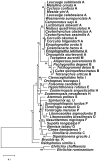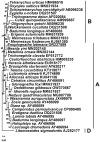Wolbachia supergroup A in Enoplognatha latimana (Araneae: Theridiidae) in Poland as an example of possible horizontal transfer of bacteria
- PMID: 38553514
- PMCID: PMC10980700
- DOI: 10.1038/s41598-024-57701-y
Wolbachia supergroup A in Enoplognatha latimana (Araneae: Theridiidae) in Poland as an example of possible horizontal transfer of bacteria
Abstract
Wolbachia (phylum Pseudomonadota, class Alfaproteobacteria, order Rickettsiales, family Ehrlichiaceae) is a maternally inherited bacterial symbiont infecting more than half of arthropod species worldwide and constituting an important force in the evolution, biology, and ecology of invertebrate hosts. Our study contributes to the limited knowledge regarding the presence of intracellular symbiotic bacteria in spiders. Specifically, we investigated the occurrence of Wolbachia infection in the spider species Enoplognatha latimana Hippa and Oksala, 1982 (Araneae: Theridiidae) using a sample collected in north-western Poland. To the best of our knowledge, this is the first report of Wolbachia infection in E. latimana. A phylogeny based on the sequence analysis of multiple genes, including 16S rRNA, coxA, fbpA, ftsZ, gatB, gltA, groEL, hcpA, and wsp revealed that Wolbachia from the spider represented supergroup A and was related to bacterial endosymbionts discovered in other spider hosts, as well as insects of the orders Diptera and Hymenoptera. A sequence unique for Wolbachia supergroup A was detected for the ftsZ gene. The sequences of Wolbachia housekeeping genes have been deposited in publicly available databases and are an important source of molecular data for comparative studies. The etiology of Wolbachia infection in E. latimana is discussed.
© 2024. The Author(s).
Conflict of interest statement
The authors declare no competing interests.
Figures




Similar articles
-
Wolbachia supergroup E found in Hypochthonius rufulus (Acari: Oribatida) in Poland.Infect Genet Evol. 2021 Jul;91:104829. doi: 10.1016/j.meegid.2021.104829. Epub 2021 Mar 29. Infect Genet Evol. 2021. PMID: 33794350
-
Alien spiders in a palm house with the first report of parthenogenetic Triaeris stenaspis (Araneae: Oonopidae) infected by Wolbachia from new supergroup X.Sci Rep. 2025 Mar 19;15(1):9512. doi: 10.1038/s41598-025-93540-1. Sci Rep. 2025. PMID: 40108258 Free PMC article.
-
Discovery of a new Wolbachia supergroup in cave spider species and the lateral transfer of phage WO among distant hosts.Infect Genet Evol. 2016 Jul;41:1-7. doi: 10.1016/j.meegid.2016.03.015. Epub 2016 Mar 18. Infect Genet Evol. 2016. PMID: 26997548
-
How diverse is the genus Wolbachia? Multiple-gene sequencing reveals a putatively new Wolbachia supergroup recovered from spider mites (Acari: Tetranychidae).Appl Environ Microbiol. 2009 Feb;75(4):1036-43. doi: 10.1128/AEM.01109-08. Epub 2008 Dec 19. Appl Environ Microbiol. 2009. PMID: 19098217 Free PMC article.
-
A survey of Wolbachia infection in brachyceran flies from Iran.PLoS One. 2024 May 22;19(5):e0301274. doi: 10.1371/journal.pone.0301274. eCollection 2024. PLoS One. 2024. PMID: 38776328 Free PMC article.
Cited by
-
Incidence of endosymbiont bacteria Wolbachia in cowpea weevil Callosobruchus maculatus Fabricius (Coleoptera, Chrysomelidae).PLoS One. 2024 Dec 10;19(12):e0313449. doi: 10.1371/journal.pone.0313449. eCollection 2024. PLoS One. 2024. PMID: 39656697 Free PMC article.
References
MeSH terms
Substances
LinkOut - more resources
Full Text Sources
Research Materials

